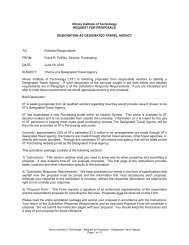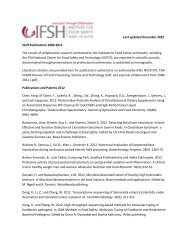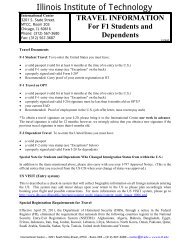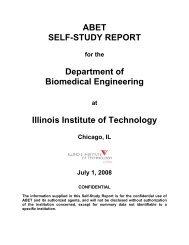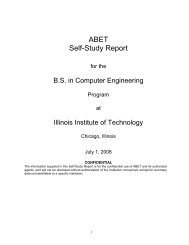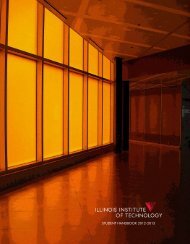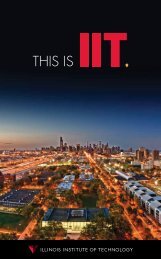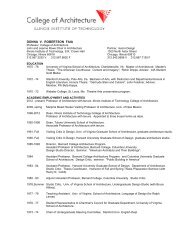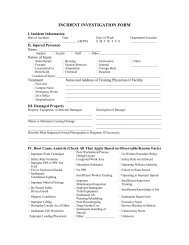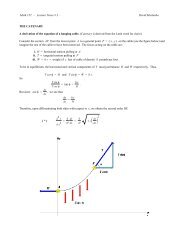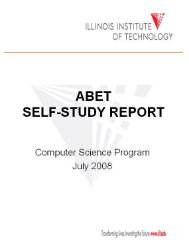Copyright & Disclaimer Information - Illinois Institute of Technology
Copyright & Disclaimer Information - Illinois Institute of Technology
Copyright & Disclaimer Information - Illinois Institute of Technology
You also want an ePaper? Increase the reach of your titles
YUMPU automatically turns print PDFs into web optimized ePapers that Google loves.
Biomedical Engineering<br />
Faculty<br />
Chair<br />
Vincent Turitto<br />
Room 116 Engineering 1<br />
Ext. 76927<br />
Undergraduate Program Director<br />
Mark Anastasio<br />
Room 118 Engineering 1<br />
Ext. 73926<br />
Pr<strong>of</strong>essor<br />
Turitto<br />
Areas <strong>of</strong> Specialization (Tracks)<br />
The biomedical program has three areas <strong>of</strong> specialization<br />
(or tracks): cell and tissue engineering, medical imaging,<br />
and neural engineering. These areas while distinct in<br />
their concept are not entirely separate, as a core exposure<br />
Cell and Tissue Engineering<br />
This area involves the more recent attempts to understand<br />
and attack biomedical problems at the microscopic<br />
level and to use such knowledge to begin to “engineer”<br />
replacement tissues and organs from individual cells.<br />
Knowledge <strong>of</strong> anatomy, biochemistry and the mechanics<br />
<strong>of</strong> cellular and sub-cellular structures is necessary in<br />
order to understand disease processes and to be able to<br />
intervene at very specific sites. With such knowledge a<br />
number <strong>of</strong> approaches have been or are being developed.<br />
These range from the development <strong>of</strong> miniature devices<br />
to deliver compounds that can stimulate or inhibit cellular<br />
processes at precise target locations in order to<br />
promote healing or inhibit disease formation and progression<br />
to the newer techniques that have produced<br />
replacement skin and one day will produce heart valves,<br />
coronary vessels and even whole hearts. This area also<br />
Medical Imaging<br />
This area combines knowledge <strong>of</strong> unique physical properties<br />
<strong>of</strong> electromagnetic and acoustic energy with<br />
high-speed electronic data processing, signal analysis<br />
and rapid display to generate an image <strong>of</strong> a body part<br />
or more recently <strong>of</strong> a bodily function. Often, these images<br />
can be obtained with minimal or completely noninvasive<br />
procedures, making them less painful and more readily<br />
repeatable than invasive techniques. Moreover, many<br />
Neural Engineering<br />
This area uses fundamental and applied engineering<br />
techniques to help solve basic and clinical problems in the<br />
neurosciences. At the fundamental level it attempts to<br />
understand the behavior <strong>of</strong> individual neurons, their<br />
growth, signaling mechanisms between neurons, and how<br />
populations <strong>of</strong> neurons produce complex behavior. Such<br />
information has broad application to a better understand-<br />
Medical School Admission<br />
For information regarding admission to medical schools<br />
see page 142 or go to www.premed.iit.edu.<br />
54 IIT Undergraduate Bulletin 2006–2008<br />
<strong>Copyright</strong> & <strong>Disclaimer</strong> <strong>Information</strong>: <strong>Copyright</strong> © 1994, 1995, 1996, 1997, 1998, 1999, 2000, 2001, 2002, 2003, 2004, 2005, 2006, 2007. CollegeSource®, Inc. and Career Guidance Foundation. CollegeSource® digital catalogs are derivative works owned and copyrighted by CollegeSource®, Inc. and Career Guidance Foundation. Catalog content is owned and copyrighted by the appropriate school. While CollegeSource®, Inc. and Career Guidance Foundation provides information as a service to the public, copyright is retained on all digital catalogs.<br />
<strong>Copyright</strong> & <strong>Disclaimer</strong> <strong>Information</strong>: <strong>Copyright</strong> © 1994, 1995, 1996, 1997, 1998, 1999, 2000, 2001, 2002, 2003, 2004, 2005, 2006, 2007. CollegeSource®, Inc. and Career Guidance Foundation. CollegeSource® digital catalogs are derivative works owned and copyrighted by CollegeSource®, Inc. and Career Guidance Foundation. Catalog content is owned and copyrighted by the appropriate school. While CollegeSource®, Inc. and Career Guidance Foundation provides information as a service to the public, copyright is retained on all digital catalogs.<br />
Associate Pr<strong>of</strong>essors<br />
Anastasio, Mogul, Troyk<br />
Assistant Pr<strong>of</strong>essors<br />
Arfanakis, Brey, Derwent, Hall, Kamper<br />
Research Pr<strong>of</strong>essor<br />
Opara<br />
Senior Lecturers<br />
Fagette, Papavasiliou<br />
Faculty Emeritus<br />
Arzbaecher<br />
to the physical, chemical, biological and engineering<br />
sciences is common to all and there is potential for considerable<br />
crossover among the areas at the upper division<br />
level. This is indicated by the track course options.<br />
includes the development <strong>of</strong> artificial materials used for<br />
implantation. Understanding the properties and behavior<br />
<strong>of</strong> living material is vital in the design <strong>of</strong> implant materials.<br />
The use <strong>of</strong> materials to place in the human body has<br />
been practiced for over 100 years, but it remains as one <strong>of</strong><br />
the most difficult tasks faced by the biomedical engineer.<br />
Certain metal alloys, ceramics, polymers, and composites<br />
have been used as implantable materials. Biomaterials<br />
must not only function normally over the lifespan <strong>of</strong> the<br />
recipient but also, be nontoxic, non-carcinogenic, chemically<br />
inert, stable, and mechanically strong enough to<br />
withstand the repeated forces <strong>of</strong> a lifetime. Few materials<br />
meet all such specifications. Newer biomaterials are<br />
being developed which incorporate proteins or living cells<br />
in order to provide a truer biological and mechanical<br />
match for the living tissue.<br />
<strong>of</strong> the devices require no ionizing radiation doses lessening<br />
the danger <strong>of</strong> secondary radiation effects on the<br />
patient. The students learn the theoretical bases underlying<br />
the common forms <strong>of</strong> medical imaging, such as<br />
magnetic resonance imaging (MRI), computerized axial<br />
tomography scanning (CAT-scan), positron emission<br />
tomography (PET), and the limitations and the applicability<br />
<strong>of</strong> such techniques.<br />
ing <strong>of</strong> the communication that occurs between the various<br />
parts <strong>of</strong> the nervous system and the brain. For example,<br />
such an understanding can be applied to the development<br />
<strong>of</strong> replacement parts for impaired neural systems, such as<br />
the auditory, visual and motor systems as well as achieving<br />
a better understanding <strong>of</strong> how normal and diseased<br />
systems work.



